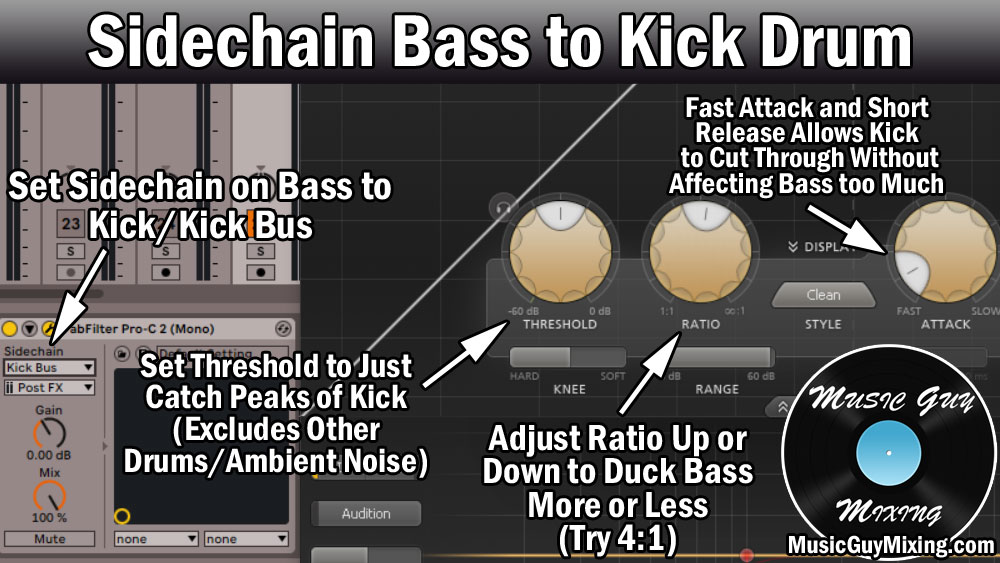Sidechain compression is a great way to create space in your mix every time you have two instruments fighting for the same fundamental frequencies. This is especially useful when panning isn’t an option to get two tracks outside of each other’s way. Let’s identify what is sidechain compression and how to use it in your mix.
What is Sidechain Compression
Whenever you’re using sidechain processing on a track, this means that plugin reacts based on the behavior of a different track. Two of the most common applications of sidechain processing are sidechain compression and sidechain EQ.

In the case of sidechain compression, we’re compressing one track based on the behavior of another track.
You’ll find the sidechain option in different spots depending on the compressor. In Ableton Live’s stock compressor, there’s a sidechain button on the top left as I explained in my guide to Ableton sidechain compression.

This allows you to select which track you want to dictate the behavior of the sidechain compressor (“Audio From”).
You also need to select pre or post FX. This determines at what stage in the “Audio From” track’s signal chain that you want to pull the audio from to affect the threshold of the compressor.
“Post FX” means that it takes the level of the audio after all processing in the signal chain, whereas “Pre FX” takes the level of the raw audio, before any plugins have altered it.
Regarding the rest of the settings, with sidechain compression, you set your compressor up like you normally would, just bearing in mind that the threshold’s behavior is being affected by the other track rather than the one the compressor is on.
Here’s a graphic showing how to sidechain bass to kick using sidechain compression:

With the bass being the more constant playing track of the two and the kick being the more paramount track you want to have presence whenever it plays, sidechain compression ensures that these two tracks which share the same stereo position (center) and frequencies (below 100Hz) can exist without one covering the other up.
By setting the threshold to catch the peaks of the kick as shown above, sidechain compression ducks the bass in volume whenever the kick plays for a split second, ensuring the kick has a clean space to exist in when needed to cut through the mix.
You can even isolate the threshold dictated by the “Audio From” track to a specific frequency range from it.
For instance, let’s say you want to sidechain your bass to your kick but you only have one entire drum track to work with (as opposed to multiple drum mics/tracks where you’d gate your drums).
In the case of Ableton Live’s compressor, ticking the “EQ” button next to the sidechain button and selecting a bell filter (see EQ filter types) or low pass filter and just including the 50-100Hz region, you’re telling the compressor on your bass to only use that frequency range of the drum kit to dictate the threshold behavior.
This effectively cuts out the rest of the drum kit, as otherwise the bass would constantly be compressed. You can do the same thing for virtually any piece in your drum kit or any instrument, it’s all about finding the fundamentals (incidentally, check out my EQ cheat sheet which shows the fundamental frequencies and how to EQ every instrument in your mix).
Of course sidechain compression isn’t the only form of sidechain processing. Sometimes you might want to use the sidechain EQ which I alluded to earlier.
The difference being that sidechain EQ only pulls out a specific frequency from the track you want to duck rather than pulling down the volume of the entire track.
In the case of our bass, sometimes we might only want to pull out the fundamental of the kick in our bass as I demonstrated in my sidechain EQ tutorial. This leaves the rest of the bass untouched (including the transients) for a more transparent adjustment to accommodate for the kick.
Ultimately sidechain compression is another tool in our belts when we need to get two or more tracks which are conflicting with one another to work together, or just get some fun and interesting results with a more dynamic compression.

Pingback: What is Sidechain EQ and How to Use It - Music Guy Mixing
Pingback: Sidechain Compression Vs Sidechain EQ - Which is Better - Music Guy Mixing